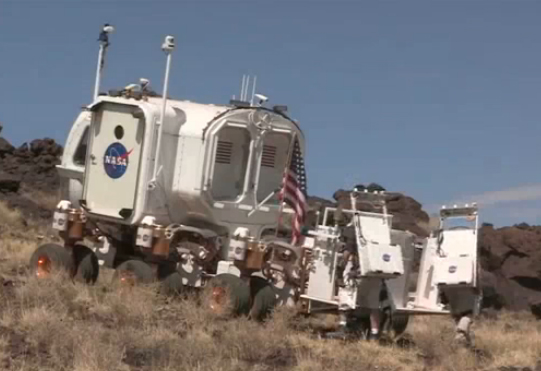NASA Turns to 3D Printing for Space Exploration Vehicle

NASA’s Space Exploration Vehicle undergoing testing. Courtesy of Stratasys.
Latest News
August 22, 2012
I imagine you’ve heard something recently about a certain rover successfully landing on Mars. Curiosity is currently tooling around on the red planet taking snapshots and doing analysis. Part of the purpose for the rover’s visit is to determine what challenges need to be overcome to send astronauts to Mars.
Designing a vehicle sturdy enough to survive the launch from Earth, through the vacuum of space and onto the surface of Mars itself is no small feat. It must be rugged enough to function, yet still light enough to get off the ground. NASA is currently in the planning and testing phase of the Space Exploration Vehicle (SEV) and has turned to additive manufacturing (AM) to fulfill specific design demands for between 60-80 different parts.
The SEV is essentially an oversized SUV designed for two passengers. The astronauts will live and work onboard the SEV, ushering in a new chapter in manned space exploration. NASA is taking advantage of AM because of the possibilities it offers for design.
“Sometimes traditional manufacturing methods don’t really work for some parts that you want to build, where you can do it with additive manufacturing and it’s really simple,” said Christopher Chapman, NASA test engineer. “It really takes no effort for what would otherwise be a very complex process.”
NASA turned to Stratasys and its Fused Deposition Modeling (FDM) process to build parts such as flame retardant ducting to create a safe environment for the pilots. As well as end-use parts, NASA uses AM for rapid prototyping to ensure each part functions in the manner for which it was designed. NASA also uses rapid prototyping to ensure the parts they order from manufacturers will fit properly in the SEV, which reduces costs.
Added to the usual benefits of using AM, if NASA finds room in the SEV for even a small 3D printer, the crew can create parts on the go. NASA has already begun to investigate the possibilities for creating new parts using AM. The benefits of being able to create a replacement part when the nearest storeroom is millions of miles away are pretty obvious.
Below you’ll find a video that discusses the SEV and the role AM is taking in its construction.
Source: Stratasys
Subscribe to our FREE magazine, FREE email newsletters or both!
Latest News
About the Author
John NewmanJohn Newman is a Digital Engineering contributor who focuses on 3D printing. Contact him via [email protected] and read his posts on Rapid Ready Technology.
Follow DERelated Topics







